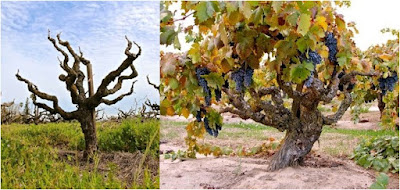Concern about climate change is a real thing with grape growers and winemakers. Wine grape varieties are very susceptible to year-to-year weather changes. This means they will have problems with warmer growing seasons.
Growers and winemakers are looking at ways to lessen the impact of hotter weather. One way is with trellising of grape vines in the vineyards. Climate change problems can be mitigated with the grape clusters' sun exposure.
 |
| Head Trained Vines, in winter after pruning, and months later with fruit images from lodiwine.com |
Choosing a trellising method for commercial vines has to do with economics and fruit quality. Economics include the ease of maintaining and picking the fruit, plus the number of vines you can get per acre. Quality has to do with even ripening, too much or too little sun, and air flow to prevent spoilage. Grapes on different trellis systems can take different amounts of water.
Actually, what trellising is used has a lot to do with when the vines were planted as different trellising, or no trellising, has gone in and out of favor over time. Also with where the vines are planted as different parts of the world use different systems.
Following are three popular local methods used for growing grapes. There are other trellising methods and variations on the ones listed.
Head Trained
19th and early 20th century grape vines are done this way. You still see lots of these vines in Sonoma County, often it's Zinfandel or Petite Sirah. Pruning, thinning and harvesting are difficult and must be done manually by skilled labor. The clusters can ripen unevenly, moisture within the canopy of leaves can cause problems. Production per vine is lower than with other trellising systems.
The best part, related to climate change, is the grape clusters get dappled sunlight. However, with the issues listed above, you're not going to see a return to head trained vines.
 |
| Cordon (meaning a trunk or spur) trellis |
Cordon Trained
This method seemed to be all the rage during the post-war growth in vineyard plantings. I remember seeing a lot of vines with clusters growing off horizontal spurs in the '80s. You will still see a lot of these t-shaped vines around. There are a couple issues with using these spurs year-after-year. Most seem to prefer canes that allow more flexibility in growing grapes. So it doesn't seem more of the traditional double or single cordon vines.
In the picture above right, you see the fruit in the open. Most of this is from manually pulling leaves to expose the grape clusters, so sunlight could be controlled.
 |
| VSP trellising, after pruning and will lots of low-hanging fruit Annual new spurs grow vertically up the wires |
Vertical Shoot Positioning
VSP has been all the rage for a few decades. Clusters get full sunlight, airflow, and access to any sprays used. Easy to weed underneath and good for mechanical harvesting. The full sun exposure is great for many coastal areas that might struggle for sunshine in the summer.
In a hotter climate, the grapes are overexposed to the sun and can get sunburn. As popular as this method is for local vineyards, it seems to be the worst choice for warmer growing seasons.
The Fix?
There is evaluation going on of other known methods of trellising and some new ones that use the leaves for sunlight control. Exactly what will work best in a given area is an expensive experiment in converting to a new system. Some of the research is shown in the image below from Frontiers.
At any rate, it looks like a return to clusters filtered by the leaf canopy. Along with that comes manual labor to thin the leaves, allowing just the right amount of sunlight through.
 |
| One of the experiments being conducted Click on image to enlarge |
No comments:
Post a Comment